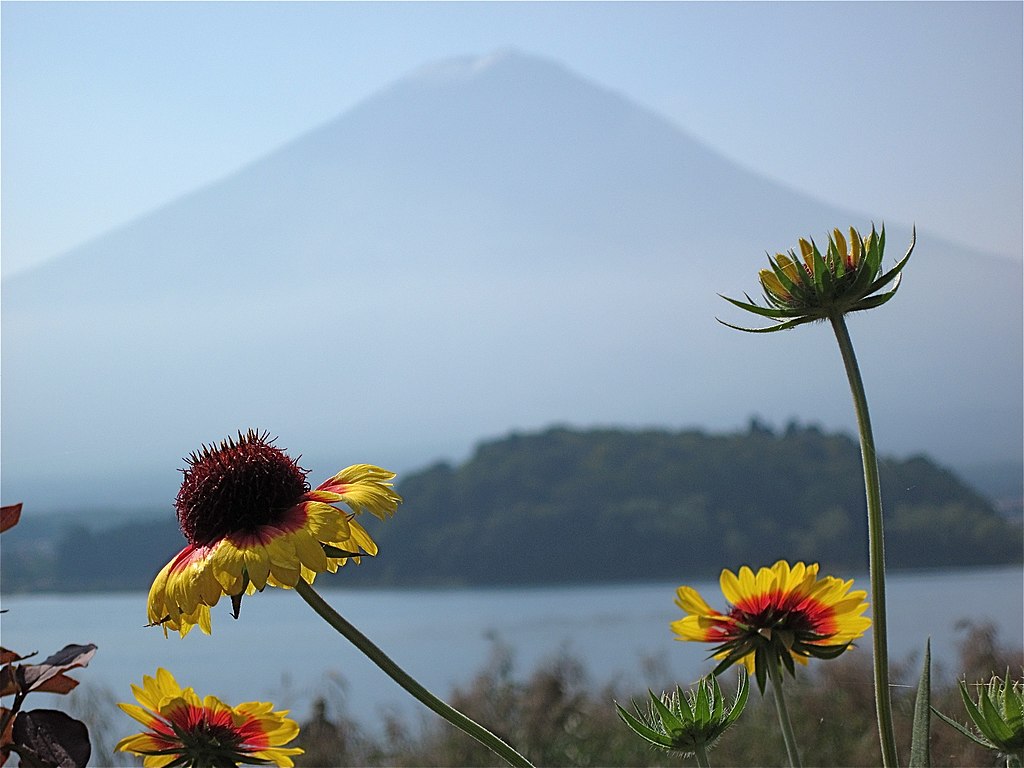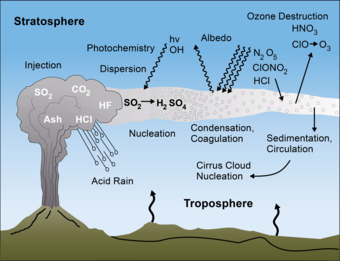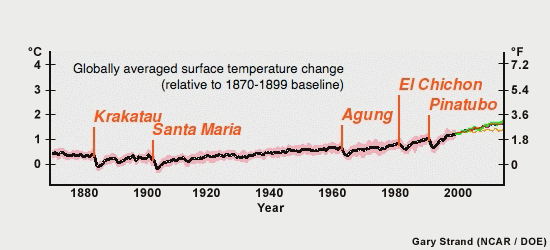If you have watched the news at all in the last two weeks, you know that there was a huge underwater volcanic eruption near Tonga in the South Pacific Ocean on January 15, 2022, that spewed ash and gases into the atmosphere. It blew with such force that the sound of the eruption was heard in Alaska thousands of miles away and the atmospheric pressure wave it set off has traveled around the earth as many as ten times according to satellite and ground-based sensors. With such a large signal, you might wonder what impact the eruption could have on our weather and climate for the next year. In this post, we will explore how volcanoes in general can affect the climate around the world and whether the Tonga eruption is likely to change our gardens’ climate this year.

Flowers growing under the volcano. Source: cogdogblog, Commons Wikimedia
What do volcanic eruptions emit into the atmosphere?
When volcanoes erupt they put out both ash and gases. The ash is made of tiny particles of rocky material from solidified lava and sometimes pieces of the volcano destroyed by the eruption. These particles are carried downwind in a direction determined by the winds at the heights to which the ash can rise. In a long eruption, the plume of ash can blow in a different direction each day, covering the ground when it falls back to earth. Usually ash does not rise very high in the atmosphere because it is quite heavy and so most of it falls out in just a few days.

Volcanoes also emit gases as they erupt. About 99 percent of all emissions are water vapor, carbon dioxide, and sulfur dioxide, with some trace amounts of hydrogen sulfide, carbon monoxide, and other minor gases. The gases are lighter than ash and so they can get lofted much higher up into the atmosphere than ash can. Because water vapor and carbon dioxide are greenhouse gases volcanic eruptions are often blamed for the recent rise in carbon dioxide in the atmosphere instead of human causes. A careful analysis of the relative amounts of carbon dioxide from the two sources easily shows that volcanic activity only contributes in a small way to greenhouse warming compared to fossil fuel burning and land-use changes. But the gases emitted do have a short-term effect on climate that can last several years in the largest tropical eruptions.

What causes volcanic cooling?
Volcanic cooling of the climate is due mainly to the effects of sulfur dioxide and water vapor. As the gases rise, the water vapor condenses and joins with the sulfur dioxide to form tiny droplets of sulfuric acid that can rise to 50,000 feet or more, higher than most commercial jets fly. Those droplets are as shiny as the glass beads they use in stop-sign paint to make the signs reflective, and the droplets have the same effect on incoming sunlight. When they reflect sunlight back to space before it can reach the earth’s surface it reduces the energy we receive at the ground, and the earth gets cooler until those droplets fall out of the atmosphere. Because of their height and small size, that can take several years.

How does the cooling affect global climate?
We know that when you have a large volcanic eruption emitting a lot of sulfur dioxide, especially if it happens in the tropics where the sunlight is most direct, you can see cooling around the globe for the next 2-7 years depending on how much gas the eruption puts out. In the worst case, an eruption like Mount Tambora in 1815 in present-day Indonesia (along with some other eruptions around the same time) resulted in the “Year Without a Summer” in 1816. In the United States, frost was observed every month of the year in New England and eastern Canada, resulting in the loss of many crops. Even the crops that survived had low yields and poor quality that resulted in dramatic increases in food prices. Europe also saw very cold temperatures that resulted in food shortages there.
Other more recent eruptions have also had some impact on global climate, although none was as severe as the Tambora eruption. The most recent large eruption that affected global climate occurred in 1991 with the eruption of Philippine volcano Mount Pinatubo. As the volcanic emissions spread around the globe, the earth’s annual temperature dropped by almost 1 degree F in the years 1991–1993. Sunsets were also spectacular with the scattering of sunlight from the aerosols high in the atmosphere. Some scientists think painters like J. M. W. Turner were inspired by the spectacular sunsets that occurred after volcanic eruptions in the 1800’s.

Will the Tonga eruption affect the climate in our gardens in the next few years?
Since this is a blog for gardeners, you might want to know if the recent eruption will affect the climate in the same way that other eruptions like Tambora and Pinatubo did. If it is going to be much colder than average, then that could affect what you plant in your garden, especially if the plants you want to use are sensitive to frost. Or it could tell you that you might want to hold off on planting those tomato seedlings a little later than usual in spring. In this case, the amount of sulfur put out by the Tonga volcano was only about 60 kilotons compared to 20,000 for Pinatubo, so any cooling effects from the most recent eruption are so small that we will not be able to observe them. Gardeners can breathe a sign of relief this time! But when the next big eruption occurs, the climate may temporarily cool for a few years before it starts to warm again under the impacts of the “human volcano” emitting many more gases and pollutants than natural volcanoes into the atmosphere.
These climate explanations are much appreciated. You have an excellent way of anticipating what we would like to better understand about this part of our world.
Thank you, that was very interesting!